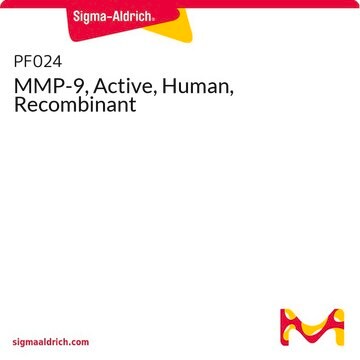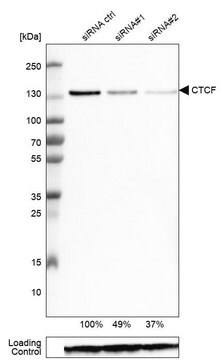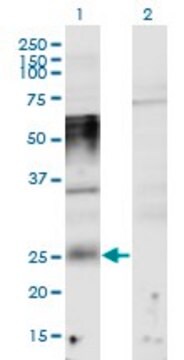17-10044
ChIPAb+ CTCF - ChIP Validated Antibody and Primer Set
clone 1.2.1.5.4, from mouse
Sinônimo(s):
11 zinc finger transcriptional repressor, 11-zinc finger protein, CCCTC-binding factor, CCCTC-binding factor (zinc finger protein), CTCFL paralog, transcriptional repressor CTCF
About This Item
Produtos recomendados
fonte biológica
mouse
Nível de qualidade
forma do anticorpo
purified immunoglobulin
clone
1.2.1.5.4, monoclonal
reatividade de espécies
human
fabricante/nome comercial
ChIPAb+
Upstate®
técnica(s)
ChIP: suitable
ELISA: suitable
dot blot: suitable
immunohistochemistry: suitable
immunoprecipitation (IP): suitable
multiplexing: suitable
western blot: suitable
Isotipo
IgG1κ
nº de adesão NCBI
nº de adesão UniProt
Condições de expedição
dry ice
Informações sobre genes
human ... CTCF(10664)
Descrição geral
The ChIPAb+ CTCF set includes the CTCF antibody, a negative control antibody (normal mouse IgG), and qPCR primers which amplify a 165 bp region of human H19 internal control region. The CTCF and negative control antibodies are supplied in a scalable "per ChIP" reaction size and can be used to functionally validate the precipitation of CTCF-associated chromatin.
Especificidade
Imunogênio
Aplicação
Sonicated chromatin prepared from HeLa cells (1 X 106 cell equivalents per IP with 15 min fixation) were subjected to chromatin immunoprecipitation using 2 µg of either Normal Mouse IgG or 2 µg of Anti-CTCF and the Magna ChIP G Kit (Cat. # 17-611).
Successful immunoprecipitation of CTCF associated DNA fragments was verified by qPCR using ChIP Primers, Human H19 ICR as a positive locus, and a representative published negative locus (Wendt, K.S., et al., 2008) (Please see figures). Data is presented as percent input of each IP sample relative to input chromatin for each amplicon and ChIP sample as indicated.
Please refer to the EZ-Magna ChIP A (Cat. # 17-408) or EZ-ChIP (Cat. # 17-371) protocol for experimental details.
Western Blot Analysis:
Representative lot data.
K562 cell lysate was resolved by electrophoresis, transferred to PVDF membranes and probed with Anti-CTCF, clone 1.2.1.5.4 (1 μg/mL).
Proteins were visualized using a Goat Anti-Mouse conjugated to HRP and a chemiluminescence detection system (Please see figures).
The following molecular weights have been reported in the literature: 180 kDa (CTCF-180), 130 kDa (CTCF-130), 82 kDa (CTCF-82), 70 kDa (CTCF-70). See Klenova, E.M., et al, (1997) Nucleic Acids Res. 25, 466–473 and Torrano,V., et al, (2006) Journal of Cell Science 119, 1746-1759) for additional details.
Please see molecular weight section for additional information.
Qualidade
Sonicated chromatin prepared from HeLa cells (1 X 106 cell equivalents per IP with 15 min fixation) were subjected to chromatin immunoprecipitation using 2 µg of either Normal Mouse IgG or 2 µg of Anti-CTCF and the Magna ChIP® G Kit (Cat. # 17-611). Successful immunoprecipitation of CTCF associated DNA fragments was verified by qPCR using ChIP Primers Human H19 ICR (Please see figures).
Please refer to the EZ-Magna ChIP A (Cat. # 17-408) or EZ-ChIP (Cat. # 17-371) protocol for experimental details.
Descrição-alvo
Note: Poly(ADP-ribosyl)ated isoform, C-terminal truncation, or sumoylation will cause variable migration of CTCF protein on SDS–PAGE, which may present CTCF with different molecular weight on Western Blot. Modifications are dependent on cell type and growing condition.
The following molecular weights have been reported in the literature: 180 kDa (CTCF-180), 130 kDa (CTCF-130), 82 kDa (CTCF-82), 70 kDa (CTCF-70). See Klenova,E.M.,et al, (1997) Nucleic Acids Res. 25, 466–473 and Torrano,V,et al, (2006) Journal of Cell Science 119, 1746-1759) for additional details.
forma física
Normal Mouse IgG. Two vials containing 25 µg purified IgG in 25 µL storage buffer containing 0.1% sodium azide. Store at -20°C.
ChIP Primers, Human H19 ICR. One vial containing 75 μL of 5 μM of each primer specific for human H19 internal control region. Store at -20°C.
FOR: CCC ATC TTG CT GACC TCAC
REV: AGA CCT GGG ACG TTT CTG TG
Nota de análise
Includes negative control mouse IgG antibody and primers specific for human H19 ICR.
Informações legais
Código de classe de armazenamento
10 - Combustible liquids
Certificados de análise (COA)
Busque Certificados de análise (COA) digitando o Número do Lote do produto. Os números de lote e remessa podem ser encontrados no rótulo de um produto após a palavra “Lot” ou “Batch”.
Já possui este produto?
Encontre a documentação dos produtos que você adquiriu recentemente na biblioteca de documentos.
Nossa equipe de cientistas tem experiência em todas as áreas de pesquisa, incluindo Life Sciences, ciência de materiais, síntese química, cromatografia, química analítica e muitas outras.
Entre em contato com a assistência técnica







